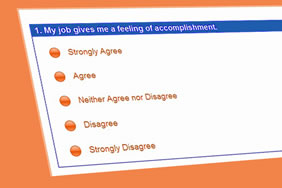Employee Satisfaction Surveys do more than simply provide a platform for everyone to be heard; they hold up a mirror to your business practices and culture.
Here are some basic guidelines to follow when conducting an Employee Satisfaction Survey:
DO:
- Notify employees in advance via email that you'll be launching a survey asking for their feedback. A clear communication strategy with a concise schedule of events and deliverables will help support the survey process. When employees understand the process, they are more likely to participate and provide candid feedback.
- Communicate with staff about the purpose behind your survey. Overall goals and objectives need to be anticipated and a Return on Investment should be established early on in the survey process. Without long-term objectives, the survey results will remain hidden in data silos.
- Make your Employee Satisfaction Survey anonymousin order to get the most candid responses. If your employees know that their responses cannot be identified, they are more likely to answer survey questions honestly, providing you with the best feedback.
- Provide the results of your survey to all employees and share your next steps. A regular dialogue with your employees will build confidence in the survey process. Always share your analysis and create a visible action plan that you refer to often.
- Follow through on your next steps. Make sure to follow through by carrying out your proposed next steps, thereby further motivating employees to participate in future Employee Satisfaction Surveys.
- Forget to give employees plenty of time to participate in your survey. A survey administration schedule will help organize the workflow of creating and hosting a live survey. Plan a generous amount of time to collect responses and send out regular reminders.
- Breach the privacy policy — especially by singling out individual employee feedback. If you create an anonymous survey, keep the data namelessso employees feel comfortable sharing honest feedback. Do not ask any question that can identify a specific employee.
- Fail to communicate the findings or use of your survey. Remember to discuss survey results with your participants and inform everyone about how the findings will influence future plans and decisions.
- Create a lengthy survey. Keep the questions short and concise. If your goal is to collect quality data, keep your survey as specific and to the point as possible. Always keep your survey purpose top-of-mind when designing questions.







